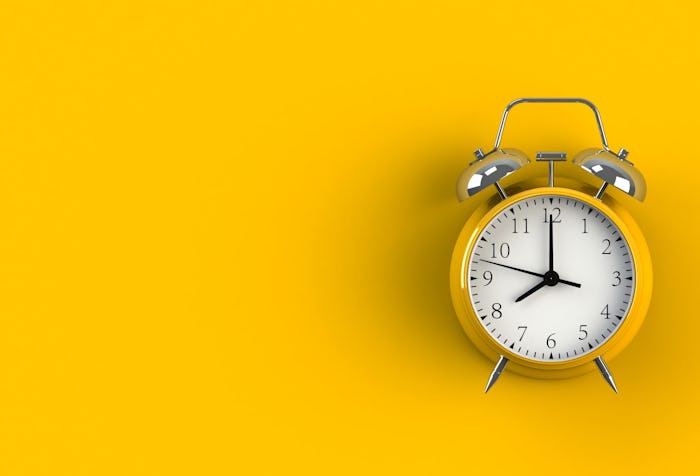Life

Here's When You'll Need To Turn Your Clocks Back This Fall
Fall is my favorite time of year for several reasons. My birthday is at the end of September, I love the cooler temperatures, Halloween is the best, the clothing styles are way better, beautiful leaves are falling, Thanksgiving is my other favorite holiday, and of course, daylight saving time ends — theoretically giving us an extra hour of sleep. So when do we “fall back” in 2018?
In 2018, daylight saving time (DST) ends at 2 a.m. on Sunday, Nov. 4, according to almanac.com. And unless you have children or pets, please enjoy that extra time in bed for the rest of us. So why do we “spring forward” then “fall back” every year? There are actually a couple of theories about who officially founded DST, and there has been a lot of back and forth about the idea for a long time in our history.
One theory, according to almanac.com, is that we have Ben Franklin to thank for DST. “Benjamin Franklin’s An Economical Project, written in 1784, is the earliest known proposal to ‘save’ daylight. It was whimsical in tone, advocating laws to compel citizens to rise at the crack of dawn to save the expense of candlelight,” the website noted.
However, another theory is that DST’s true founder was William Willet, who came up with the idea during an early morning horse ride, according to almanac.com. “He noticed that the shutters of houses were tightly closed even though the sun had risen.” In The Waste of Daylight, the manifesto of his personal light-saving campaign, he said that “everyone loves the long light evenings," and “laments their shrinkage as the days grow shorter, and nearly everyone has given utterance to a regret that the nearly clear, bright light of an early morning during spring and summer months is so seldom seen or used,” according to almanac.com.
Willet called it a “defect in our civilization.” So he “spent a small fortune” trying to convince Parliament and even U.S. Congress, as well as businessmen to “put clocks ahead 20 minutes on each of the four Sundays in April, and reverse the process on consecutive Sundays in September,” which was the earliest idea for DST. Thankfully that didn’t stick, because that seems super complicated. And apparently, everyone else thought it was nuts too, and even went so far as to call it a sin because they were being asked to lie about the time. It took all the way until World War I for the idea of DST to stick.
It was adopted in the United States as a coal saving measure, which was used to heat homes at the time. Germany was first, Britain was second, and the United States was third in adopting DST. “Congress passed the Standard Time Act, which established time zones,” but the people were not happy. However, when DST was touted as a way to help the war effort, folks changed their minds. “Suddenly, energy conservation was of paramount importance, and several efforts were launched to enlist public support for changing the clocks. A group called the National Daylight Saving Convention distributed postcards showing Uncle Sam holding a garden hoe and rifle, turning back the hands of a huge pocket watch,” almanac.com noted. They decided if they had more daylight, they could work longer for their country. They thought food supply for allies would grow because of that extra hour of daylight, and there were posters made that said, “Uncle Sam, your enemies have been up and are at work in the extra hour of daylight — when will YOU wake up?” the website said.
So on March 31, 1918, the first official DST began. Though not everyone was a fan. I know everyone (including myself) has always been told that farmers were the reason for DST, but in actuality, they opposed it, saying it was for white collar folks and others who were in the “leisure class.” So while they were doing their farm chores in darkness their “city brother may enjoy a daylight motor ride in the evening,” almanac.com said. So the law was repealed in 1920, but it came back after the attack on Pearl Harbor in 1941 — “this time, to save fuel,” according to the website. What was once up to each state, DST changed to how we know it today with the Energy Policy Act of 2005.
Whew. After all that, don’t forget to change your clocks on Nov. 3 before you go to bed, and hopefully you can enjoy that extra hour of sleep thanks to those who came before us and fought to not waste any good daylight. It was a long and winding road to get here. Sorry farmers.